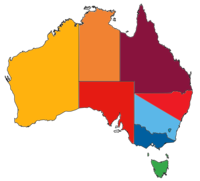Related Research Articles
The Football Federation South Australia 2012 season was the final season under the previous competition format in South Australia. The competition consisted of three divisions across the State of South Australia. At the end of the season, the ten FFSA Super League teams were joined by the top four teams from the FFSA Premier League to form the new National Premier Leagues South Australia. The remaining six FFSA Premier League teams were joined by the ten FFSA State League teams to create the new second tier of South Australian football.
The Football Federation South Australia 2011 season was the sixth season under the previous competition format in South Australia. The competition consisted of three divisions across the State of South Australia.
The Football Federation South Australia 2010 season was the fifth season under the previous competition format in South Australia. The competition consisted of three divisions across the State of South Australia.
The South Australian Soccer Federation 2005 season was the final season ran by the SASF, which was replaced by the Football Federation South Australia. The competition consisted of two divisions of twelve teams each, across the State of South Australia.
The Football Federation South Australia 2009 season was the fourth season under the previous competition format in South Australia. The competition consisted of three divisions across the State of South Australia.
The South Australian Soccer Federation 2004 season was the second-last season run by the SASF. The competition consisted of two divisions of twelve teams each, across the state of South Australia.
The South Australian Soccer Federation 2003 season consisted of two divisions of twelve teams each, across the State of South Australia.
The Football Federation South Australia 2008 season was the third season under the previous competition format in South Australia. The competition consisted of three divisions across the State of South Australia.
The Football Federation South Australia 2007 season was the second season under the previous competition format in South Australia. The competition consisted of three divisions across the State of South Australia.
The Football Federation South Australia 2014 season was the second season under the new competition format in South Australia. The competition consists of two divisions across the State of South Australia. The overall premier for the new structure qualified for the National Premier Leagues finals series, competing with the other state federation champions in a final knockout tournament to decide the National Premier Leagues Champion for 2014.
The South Australian Soccer Federation 2002 season consisted of two divisions of twelve teams each, across the State of South Australia.
The South Australian Soccer Federation 2001 season consisted of two divisions of twelve teams each, across the State of South Australia.
The South Australian Soccer Federation 1999 season consisted of two divisions, one of twelve and one of thirteen teams, across the State of South Australia.
The Football Federation Tasmania 2013 season was the first season under the new competition format in Tasmania. The competition consists of three major divisions across the State of Tasmania, created from the teams in the previous structure. The overall premier for the new structure qualified for the National Premier Leagues finals series, competing with the other state federation champions in a final knockout tournament to decide the National Premier Leagues Champion for 2013.
The 2014 Northern NSW Football season was the first season under the new competition format in northern New South Wales. The competition consisted of six divisions across the district. The overall premier for the new structure qualified for the National Premier Leagues finals series, competing with the other state federation champions in a final knockout tournament to decide the National Premier Leagues Champion for 2014.
The South Australian Soccer Federation 1998 season consisted of two divisions, one of ten and one of twelve teams, across the State of South Australia.
The Football Federation Tasmania 2014 season was the second season under the new competition format in Tasmania. The competition consists of three major divisions across the State of Tasmania, created from the teams in the previous structure. The overall champion for the new structure qualified for the National Premier Leagues finals series, competing with the other state federation champions in a final knockout tournament to decide the National Premier Leagues Champion for 2014.
The Football Federation Tasmania 2015 season was the third season under the new competition format in Tasmania. The competition consists of three major divisions across the State of Tasmania, created from the teams in the previous structure. The overall champion for the new structure qualified for the National Premier Leagues finals series, competing with the other state federation champions in a final knockout tournament to decide the National Premier Leagues Champion for 2015.
The 2017 Football Federation South Australia season was the fifth season under the National Premier Leagues competition format in South Australia.
The 2018 Football Federation South Australia season was the sixth season under the National Premier Leagues competition format in South Australia.
References
- ↑ "South Australian Premier League 2000 – Schedule" . Retrieved 28 June 2014.
- ↑ "South Australian State League 2000 – Schedule" . Retrieved 29 June 2014.
